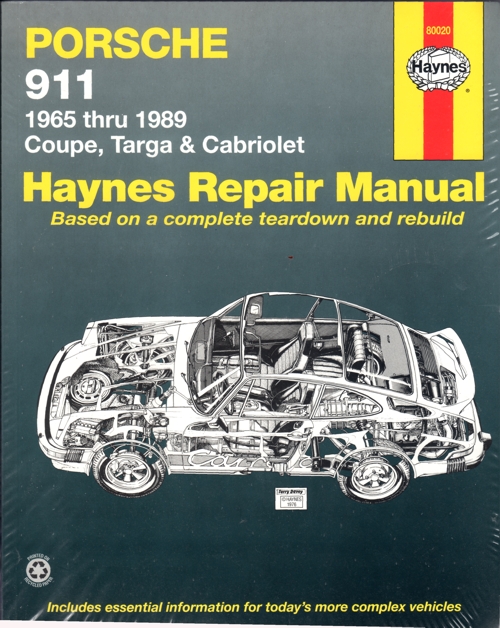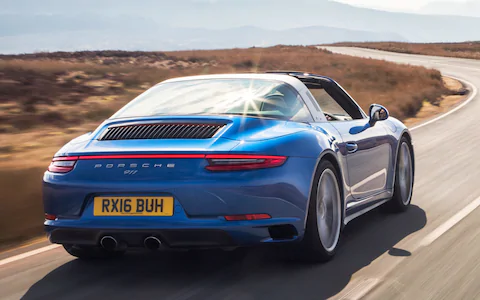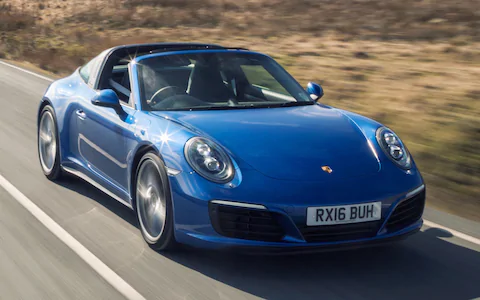Porsche 911 Coupe Targa Cabriolet 1965 1989 Haynes Service Repair Manual
|
(Softcover 344 pages). Haynes (US) publication covering Porsche 911 1965 thru 1989 normally aspirated versions. Does not include turbocharged or Carrera 4 models Engines: Fuel systems: Transmissions: Please note this manual DOES NOT cover turbocharged engine details or Carrera 4 models. |
The original Porsche 911 (pronounced as nine eleven, German: Neunelfer) was a sports car made by Porsche AG of Stuttgart, Germany. The famous, distinctive, and durable design was introduced in autumn 1963 and built until 1989. It was succeeded by a modified version, internally referred to as Porsche 964 but still sold as Porsche 911, as are current models. Mechanically, the 911 was notable for being rear engined and air-cooled. From its inception the 911 was modified both by private teams and the factory itself for racing, rallying and other types of automotive competition. The original 911 series is often cited as the most successful competition car ever, especially when its variations are included, mainly the powerful 911-derived 935 which won 24 Hours of Le Mans and other major sports cars races outright against prototypes.
The Porsche 911 was developed as a much more powerful, larger, more comfortable replacement for the Porsche 356, the company's first model, and essentially a sporting evolution of the Volkswagen Beetle. The new car made its public debut at the 1963 Internationale Automobil-Ausstellung, better known to English speakers as the Frankfurt Motor Show. The earliest editions of the 911 had a 130 PS (96 kW) flat-6 engine, in the "boxer" configuration like the 356, air-cooled and rear-mounted, displaced 1991 cm³ (cc) compared with the 356's four-cylinder, 1600 cc unit. The car had four seats although the rear seats are very small, and the car is usually called a 2+2 rather than a four-seater (the 356 was also a 2+2). It was mated to a five-speed manual "Type 901" transmission. The styling was largely by Ferdinand "Butzi" Porsche, son of Ferdinand "Ferry" Porsche. Erwin Komenda, the leader of the Porsche car body construction department, was also involved in the design.The 356 came to the end of its production life in 1965, but there was still a market for a 4-cylinder car, particularly in the USA. The Porsche 912, introduced the same year, served as a direct replacement. It used the 356's 4-cylinder, 1600 cc, 90 hp (67 kW) engine but wore the 911 bodywork.
In 1966 Porsche introduced the more powerful 911S, the engine's power raised to 160 PS (120 kW; 160 hp). Alloy wheels from Fuchs, in a distinctive 5-leaf design, were offered for the first time. In motorsport at the same time, installed in the mid-engined Porsche 904 and Porsche 906, the engine was developed to 210 PS (154 kW). In 1967 the Targa version was introduced as a "stop gap" model. The Targa had a stainless steel-clad roll bar, as Porsche had, at one point, thought that the National Highway Traffic Safety Administration (NHTSA) would outlaw fully open convertibles in the US, an important market for the 911. The name "Targa" (which means "shield" in Italian) came from the Targa Florio sports car road race in Sicily, Italy in which Porsche had notable success, with seven victories since 1956, and four more to come until 1973. This last win in the subsequently discontinued event is especially notable as it was scored with a 911 Carrera RS against prototypes entered by Italian factories of Ferrari and Alfa Romeo. The road going Targa was equipped with a removable roof panel and a removable plastic rear window (although a fixed glass version was offered alongside from 1968). The 110 PS (81 kW; 110 hp) 911T was also launched in 1967 and effectively replaced the 912. The staple 130 PS (96 kW; 130 hp) model was renamed the 911L. The 911R had a very limited production (20 in all). This was a lightweight racing version with thin aluminium doors, a magnesium crankcase, twin-spark cylinder heads, and a power output of 210 PS (150 kW; 210 hp). In 1969 the B series was introduced: the wheelbase for all 911 and 912 models was increased from 2,211 to 2,268 millimetres (87.0 to 89.3 in), an effective remedy to the car's nervous handling at the limit. The overall length of the car did not change: rather, the rear wheels were relocated aft. Fuel injection arrived for the 911S and for a new middle model, 911E. A semi-automatic Sportomatic model, composed of a torque converter, an automatic clutch, and the four speed transmission, was added to the product lineup. The 1972–1973 model years consisted of the same models of 911— the entry level T, the midrange E and the top of the line S. However, all models got a new, larger 2,341 cc (2.341 L; 142.9 cu in) engine. This is universally known as the "2.4L" engine, despite its displacement being closer to 2.3 litres— perhaps to emphasize the increase over the 2.2 L. The new power ratings were 130 hp (97 kW), or 140 hp (104 kW) in the U.S., for the T, 165 hp (123 kW) for the E and 190 hp (142 kW) for the S.
The 911E and 911S used mechanical fuel injection (MFI) in all markets. The 911T was carbureted, except in the US where it also used MFI, which accounts for the 7 kW (9 hp) power difference between the two. In January, 1973, US 911Ts were switched to the new K-Jetronic CIS (Continuous Fuel Injection) system from Bosch. These CIS-powered cars are usually referred to as "1973.5" models by enthusiasts. With the power and torque increases, the 2.4 L cars also got a newer, stronger transmission, identified by its Porsche type number 915. Derived from the transmission in the Porsche 908 race car, the 915 did away with the 901/911 transmission's "dog-leg" style first gear arrangement, opting for a traditional H pattern with first gear up to the left, second gear underneath first, etc. Some say this was because the dog-leg shift to second gear was inconvenient for city driving, other say it was due to Porsche’s desire to put 5th gear outside the main transmission housing where it could easily be changed for different races. The Sportomatic transmission was still available but only as a special order.
In 1972 a tremendous effort was made to improve the handling of the 911. Due to the 911's unusual engine placement (rear-mounted, with most of the vehicle's weight concentrated over the rear axle) early 911's were prone to oversteer when driven at the limit, and could easily spin in the hands of an inexperienced driver. In an attempt to remedy this, Porsche relocated the oil tank from its position behind the right rear wheel to in front of it. This had the effect of moving the weight of almost 9 quarts (8.5 L) of oil from outside the wheelbase to inside, improving weight distribution and thus, handling. To facilitate filling of the oil tank, Porsche installed an oil filler door (much like the fuel filler door on the left front fender) on the right rear quarter panel. Unfortunately, this unique design was scrapped after only one year, some say because inattentive gas station attendants were putting gas in the oil tank. The oil tank was subsequently moved back to its original position for model year 1973, and remained there until it was moved back within the wheelbase for the 964 models. 911S models also gained a discreet spoiler under the front bumper to improve high-speed stability. With the car's weight only 1050 kg (2315 lb), these are often regarded as the best classic mainstream 911s. For racing at this time, the 911 ST was produced in limited numbers (the production run for the ST only lasted from 1970 to 1971.) The cars were available with engines of either 2466 cc or 2492 cc, producing 270 PS (199 kW) at 8000 rpm. Weight was down to 960 kg (2166 lb). The cars had success at the Daytona 6 Hours, the Sebring 12 Hours, the 1000 km Nürburgring and the Targa Florio.
These models, valued by collectors, are considered by many to be the greatest classic 911s all-time. RS stands for Rennsport in German, meaning "racing sport". The Carrera name was reintroduced from the 356 Carrera which had itself been named after Porsche's victories in the Carrera Panamericana races in Mexico in the 1950s. The RS was built so that Porsche could enter racing formulae that demanded that a certain minimum number of production cars were made. Compared with a standard 911S, the Carrera 2.7 RS had a larger engine (2687 cc) developing 210 PS (150 kW; 210 hp) with MFI, revised and stiffened suspension, a "ducktail" rear spoiler, larger brakes, wider rear wheels and rear wings. In RS Touring form it weighed 1075 kg (2370 lb), in Sport Lightweight form it was about 100 kg (220 lb) lighter, the saving coming from the thin-gauge steel used for parts of the bodyshell and also the use of thinner glass. In total, 1580 were made, comfortably exceeding the 500 that had to be made to qualify for the vital FIA Group 4 class. 49 Carrera RS cars were built with 2808 cc engines producing 300 PS (221 kW). In 1974, Porsche created the Carrera RS 3.0 with K-Jetronic Bosch fuel injection producing 230 PS (169 kW).It was almost twice as expensive as the 2.7 RS but offered a fair amount of racing capability for that price. The chassis was largely similar to that of the 1973 Carrera RSR and the brake system was from the Porsche 917. The use of thin metal plate panels and a spartan interior enabled the shipping weight to be reduced to around 900 kg (1984 lb).
The Carrera RSR 3.0 and Carrera RSR Turbo (its 2.1 L engine due to a 1.4x equivalency formula) were made in tiny numbers for racing. The turbo car came second at the 24 Hours of Le Mans in 1974, a significant event in that its engine would form the basis of many future Porsche attempts in sportscar racing, and can be regarded as the start of its commitment to turbocharging. With the 911’s future assured, 1983 saw the launch of a replacement for the successful SC series. It was the MY 1984 911 3.2 Carrera, reviving the Carrera name for the first time since 1975. The 911 3.2 Carrera was the last iteration in the original 911 series, with all subsequent models featuring new body styling with new brake, electronic and suspension technologies.
A new higher displacement motor, a 3.2 liter horizontally opposed flat 6 cylinder, was utilized. At the time, Porsche claimed it was 80% new. The new swept volume of 3164 cc was achieved using the 95 mm (3.7 in) bore (from the previous SC model) combined with the 1978 Turbo 3.3 crankshaft's 74.4 mm (2.9 in) stroke. In addition, higher domed pistons increased the compression ratio from 9.8 to 10.3:1 (although only 9.5:1 for the US market). New inlet manifold and exhaust systems were fitted. The 915 transmission was carried over from the SC series for the first three model years. In 1987, the Carrera got a new five-speed gearbox sourced from Getrag, model number G50 with proven Borg-Warner synchronizers. This slightly heavier version also featured a hydraulically-operated clutch. With the new engine, power was increased to 207 bhp (154 kW; 210 PS) at 5900 rpm for North American-delivered cars and to 231 bhp (172 kW; 234 PS) at 5900 rpm for most other markets. This version of the 911 accelerated 0– 60 mph (97 km/h) in 5.4 seconds and had a top speed of 150 mph (240 km/h) as measured by Autocar. Factory times were more modest: 0-60 mph time of 6.3 seconds for the US version and 6.1 seconds for cars outside the American market. The disc brakes were increased in size to aid in more effective heat dissipation and improved oil-fed chain tensioners were fitted to the engine. To improve oil cooling, a finned cooler replaced the serpentine lines in the front passenger fender well. This was further improved in 1987, with the addition of a thermostatically-controlled fan. Driving refinement and motor reliability were improved with an upgrade of the fuel and ignition control components to a L-Jetronic with Bosch Motronics 2 DME (Digital Motor Electronics system). An improvement in fuel-efficiency was due to the DME providing a petrol cut-off on the overrun. Changes in the fuel map & chip programming from October 1986, further improved the power to 217 bhp (162 kW; 220 PS) at 5900 rpm for North American delivered cars as well as for other markets requesting low emissions, like Germany. Custom-mapped chips remain a popular upgrade. The fuel relay that is mounted externally on the DME is known to be a weak point of the system.
Three basic models were available throughout the Carrera years – coupe, targa and cabriolet. When launched in 1984 in the United States, the prices of the 911 Carrera lineup were ,950 for the coupe, ,450 for the targa and ,450 for the cabriolet. Almost indistinguishable from the SC, external clues are the front fog lights, which were integrated into the front valance in the Carrera. Very modest cosmetic changes were made throughout the lifespan of the Carrera, with a redesigned dash featuring larger air conditioning vents appearing in 1986. Two special editions of the Carrera were produced – the "Commemorative Edition" in 1988 to commemorate 250,000 911s produced and an "Anniversary" edition in 1989 which was the model’s 25th year of production. Both were cosmetic packages with limited production. In 1984, Porsche also introduced the M491 option. Officially called the Supersport, it was commonly known as the "Turbo-look". It was a style that resembled the Porsche 930 Turbo with wide wheel arches and the distinctive "tea tray” tail. It featured the stiffer turbo suspension and the superior turbo braking system as well as the wider turbo wheels. Sales of the Supersport were particularly strong for its first two years in the United States because the desirable 930 was not available.
The 911 Speedster (option M503), a low-roof version of the Cabriolet which was evocative of the Porsche 356 Speedster of the 1950s, was produced in limited numbers (2.104) starting in January 1989 until July 1989 as both a narrow body car and a Turbo-look. The narrow version was produced only 171 times, that means for the lucky owners an exclusive car from the very beginning. It started as a design under Helmuth Bott in 1983 but was not manufactured until six years later. It was a two-seat convertible that featured a low swept windshield. The 1987 Carrera Club Sport, of which 340 were produced, is a collectible 911 that had a blueprinted engine with a higher rev limit, and had the electric windows, electric seats, and radio removed to save a claimed 50 kg (110 lb) in weight. Total production of the 911 3.2 Carrera series was 76,473 cars (35,670 coupé, 19,987 cabrio, 18,468 targa).In late 1989, the 911 underwent a major evolution, with the introduction of the Type Porsche 964 (1989–1993).
Porsche 911 1965 - 1989 Coupe, Targa and Cabriolet Haynes repair manual NEW 1966 1967 1968 1069 1970 1971 1972 1973 1974 1975 1976 1977 1978 1979 1980 1981 1982 1983 1984 1985 1986 1987 1988
.

 0 Items (Empty)
0 Items (Empty)







 >
>